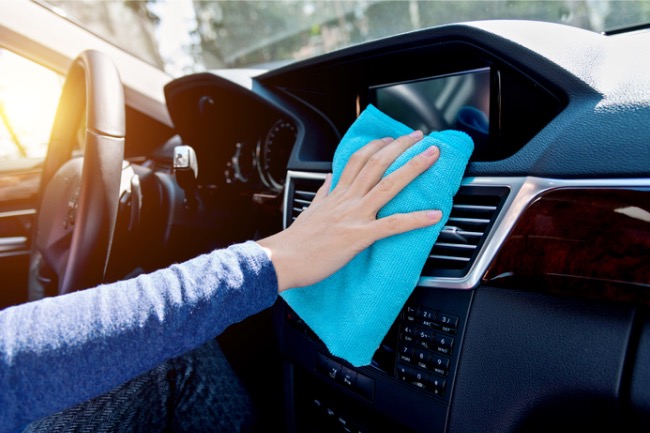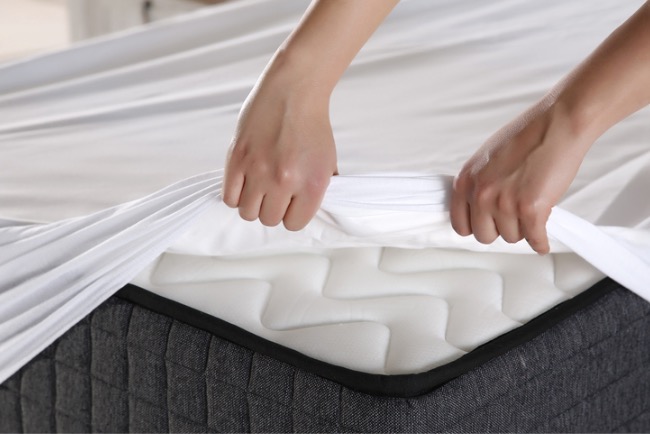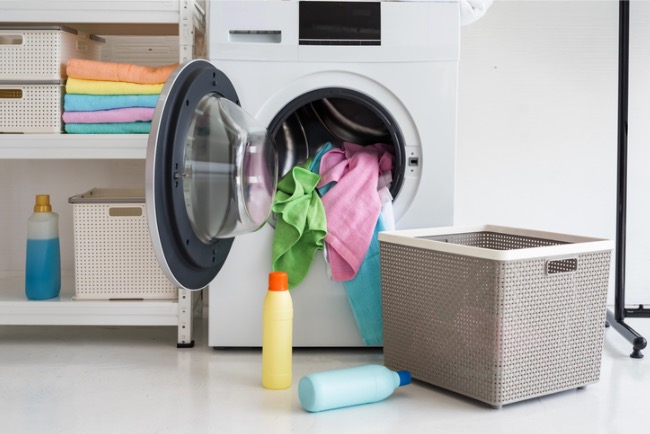

We may earn revenue from the products available on this page and participate in affiliate programs. Learn More ›
Q: Microfiber textiles have been growing in popularity, showing up in everything from cleaning cloths and mop heads to upholstery fabrics and bed linens. But exactly what is microfiber, and why should I purchase products constructed from it?
A: Microfiber, as the name suggests, is an extremely thin man-made fiber that can be spun, woven, or knitted into a wide variety of textile products. The unit of measurement for fibers is known as “denier,” which is equal to the weight of one gram per 9,000 meters of fiber length. Microfiber is defined as any fiber that measures one denier or less, which is equivalent to approximately 1/20th the diameter of silk or 1/100th the diameter of a human hair. Products constructed of microfiber are soft to the touch, non-abrasive, lightweight, and durable—and can be either water-repellent or ultra-absorbent, depending on the construction.
The fiber is constructed of polyester, nylon, polyamides or polypropylene.
Microfiber is a synthetic material first developed in the late 1950s when many manufacturers began experimenting with different polyester constructions. Most microfiber features synthetic materials, including various types of polyesters; polyamides, including nylon, Kevlar, and Nomex; and polypropylene. Some microfiber constructions use filaments of cellulose made of wood pulp.
These materials can be combined in different shapes and sizes to give the end-use products specific characteristics, including softness, durability, water absorption or water repellency, breathability, and filtration. Microfibers also can be treated with anti-bacterial chemicals, a technique often used for microfiber cleaning cloths, mops, and fabrics used in hospitals and hotels. Microfibers can be electrostatically-charged to enable them to be used as dusters or to enhance filtration.
Microfibers are used in many different types of products: upholstery fabrics, including the popular Ultrasuede brand, which was one of the first widely-used microfiber fabrics; apparel, especially athletic wear, because the material wicks away moisture; home fashions, including sheets and bedroom ensembles, bath towels and rugs, and table linens; and cleaning products, including glass cleaners, dusting cloths, faux chamois drying cloths and mops. Microfiber also can be used as an insulating fiberfill to mimic the characteristics of down in bed pillows, comforters, and sleeping bags.

Split and flat weaves are the main types.
One microfiber property is that it can be split during the manufacturing process, to produce even thinner, multi-stranded fibers, thereby creating dramatically more surface area to trap dust, dirt, oil, and grease—and to enhance liquid absorption. The individual split fibers also are naturally electrostatically-charged, and therefore attract and hold small particles of dust. This makes split microfibers ideal for various cleaning products, mops, dusters, bath towels, and bath rugs.
On the other hand, flat-woven microfibers are not split, and therefore do not have the liquid absorption capacity of split microfibers. In some cases, fabrics made from flat microfibers can be woven so tightly that they repel water, making them ideal for use in table linens and upholstery fabrics. Flat-woven microfibers are also ultra-soft and drape easily, making them desirable for apparel, fashion accessories, and bed linens.
One way to tell if a microfiber is split or flat is to rub your hand lightly over the product: if the product uses split microfibers, it will catch and cling to the tiny imperfections in your skin.
RELATED: How to Get Rid of Dust: 20 Simple Home Cleaning Tips
It’s a lightweight material.
Because most microfiber features synthetic fibers, it is very lightweight, but at the same time, microfiber is very strong, resilient, and durable. Microfiber also can be extremely long-lasting when cared for properly and laundered correctly. Microfiber is typically more porous and breathable than many other synthetic materials, and because microfiber can wick away moisture, it is ideal for athletic apparel and sportswear. Microfiber also does not “pill” easily and is very wrinkle-resistant, which explains its popularity for use in clothing, upholstery fabrics, and bed linens.

Microfiber is water repellent or water absorbing.
Depending on the type of microfiber used—split or flat fiber construction—products constructed using microfibers are either extremely water repellent or very moisture absorbing. Products comprising split microfibers contain substantially more surface area and trap and hold more moisture, dirt, and dust particles, making them ideal for cleaning applications, such as cleaning cloths, dusters, and mops. Finally, products featuring flat microfibers are ultra-soft. The fine fibers can be woven or knitted extremely tightly together, giving them water-repellent characteristics—ideal for table linens, upholstery fabrics, and automotive interiors.
It’s a useful material for upholstery, cleaning cloths, and apparel.
One of the first and most popular applications for microfibers was for upholstery fabrics. The Ultrasuede brand was invented in 1970 by Japanese scientist Dr. Miyoshi Okamoto for Toray Industries and quickly became a popular faux substitute for suede leather in the apparel, home fashion, interior design, and upholstered furniture trades. Today, microfibers are used in many popular upholstery fabrics, including chenille, because of the combination of softness, water- and stain-resistance, and durability. Many of these same characteristics have made microfibers a popular choice for apparel, especially in sportswear and accessories. The moisture-wicking action of the microfiber construction helps keep athletes cooler and drier. Fiberfill made from microfiber also is used as an alternative to down in coats, jackets, and ski apparel.
RELATED: This Is the Absolute Best Way to Clean a Couch
Microfiber became a popular cleaning choice in the 1990s, when microfiber cloths, dusters, and mops came into heavy use in Sweden and spread throughout Europe. Because products using split microfiber constructions trap and hold dust, dirt, bacteria, oil, and grease without any chemical cleansers, they are often touted as hypoallergenic alternatives. Some also consider microfibers to be more environmentally friendly because they are designed for repeated use rather than discarded. However, as with many synthetic products, there has been a growing concern about polyester fibers “shedding” in the laundry and contaminating the world’s water supply. Proponents say that municipal wastewater treatment plants filter out most microfibers, but many scientists say that more study is needed to determine the impact of microfibers on water pollution.

Microfiber requires special laundering.
Products made from microfibers are durable and long-lasting but require a little bit of TLC when it comes to laundering to maximize longevity. Microfiber fabrics should be washed with conventional laundry detergent, without additional fabric softeners or bleach. Water softeners (or detergents with softeners included) contain oils and cationic surfactants that will clog up the fibers and make them less absorbent and therefore less effective. Bleach will seriously weaken the fibers and cause the fabrics to shred or pill. It is also a good idea to avoid using the dryer on microfiber products—it is best to hang them or lie them flat to dry.
